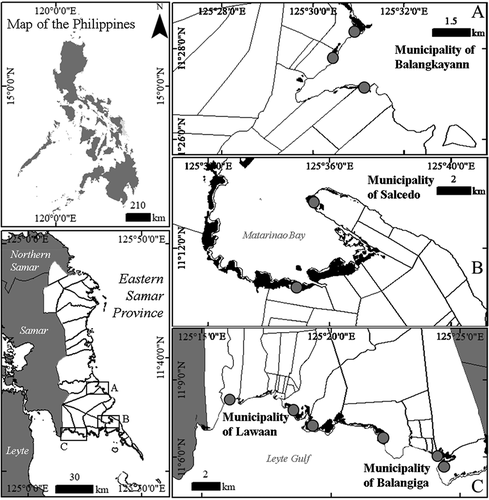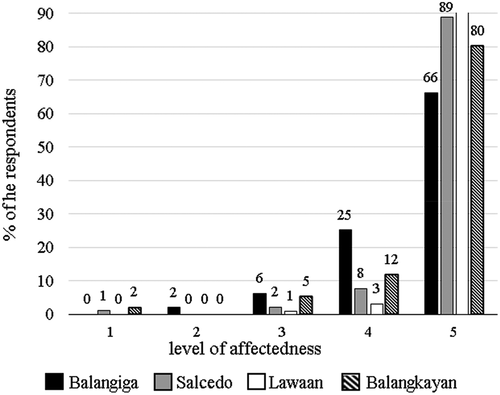ABSTRACT
The mangrove ecosystems which provide diverse benefits to local communities are vulnerable to natural and human-induced threats. Existing policies and decision-makers in the Philippines are gearing towards the integration of physical, ecological, and social elements in managing these ecosystems. To date, the linkage between the policies and the direct beneficiaries (i.e. coastal communities) of the ecosystem services is, however, largely unexplored from local perspectives applying quantitative methodology. Thus, we conducted household surveys to the coastal villagers in Eastern Samar. By doing so, we provide basic information for the scientists and policymakers on the following elements of one the blue carbon ecosystems, mangroves; (1) resource utilization, (2) level of awareness on ecosystem services and existing management plans, and (3) perceptions on natural and anthropogenic threats. Results of the survey show that the utilization of mangrove ecosystem services is influenced by social demography and level of awareness of the locals. The trends of the locals’ utilization and perceptions on the diverse ecosystem services may provide evidence for their active involvement in protecting these resources. To enable more holistic and sustainable management, this study suggests the value of including coastal communities in contextualizing management plans, particularly for the areas often visited by natural hazards.
Introduction
The mangrove ecosystems which serve as a bridge linking terrestrial and marine ecosystems are gaining salience amongst forestry scientists because of their multi-functionality (i.e. Bakhtiyari et al. Citation2019). For example, the prop-roots and pneumatophores of mangroves that extend into the intertidal and subtidal are home to diverse terrestrial as well as marine fauna and flora (Nagelkerken et al. Citation2008). Mangroves can also be an indicator of the condition of the upland environment since these ecosystems depend on terrestrial and tidal waters for their nourishment and river-derived deposits from upland erosion as substrate support (Kusumaningtyas et al. Citation2018; Bakhtiyari et al. Citation2019).
Mangrove forests along with seagrass meadows and salt marshes comprise the “blue carbon” ecosystems (Nellemann et al. Citation2009). The concept of blue carbon ecosystems developed from the need to improve the management of mangroves, seagrass beds and tidal marshes because of their important role in climate change mitigation (Crooks et al. Citation2017). Blue carbon ecosystems provide climate regulating service through the extraction of CO2 by plants directly from the atmosphere and surface waters which are eventually stored in their biomass (above and below ground) and soil material (Pidgeon Citation2009; McLeod et al. Citation2011); a process called carbon sequestration. Furthermore, mangrove forests provide regulatory service (with varying degrees and limitations) against natural hazards including storm surges brought by typhoons (Alongi Citation2008; Delfino et al. Citation2015). Although mangroves are highly productive ecosystems providing diverse ecosystem services that enhance and support local communities and national economies, they are among the most threatened ecosystems (Alongi Citation2008; Crooks et al. Citation2017).
The decline in mangrove cover may be attributed to overexploitation by coastal residents and conversion to agriculture ponds, industry and residential areas (Primavera Citation2000). Degradation and depletion of mangrove forests mean depravity and loss of their ecosystem services which would affect local communities who are dependent on them. The loss of these ecosystems has resulted in the decrease of beneficial services that they provide such as food provision, storm surge protection, climate regulation, as well as cultural and spiritual benefits (Munang et al. Citation2011; Spalding et al. Citation2013; Costanza et al. Citation2014).
The ecosystem services can be divided into four categories based on the Millennium Ecosystem Assessment (MEA): provisioning, such as food source; regulating, including climate mitigation; cultural such as a recreational site; and supporting, such as nutrient and water cycling. In recent years, the scientific community has been highly interested in incorporating ecosystem services into decision-making processes since these accounts for the importance of these services for human well-being (MEA, Citation2005; Hicks et al. Citation2015). Several studies on mangrove ecosystem have been evolving from scientific investigations into science-based management policies such as linking greenhouse gas (GHG) accounting in coastal environments for coastal management plan formulations (Crooks et al. Citation2017), and analyzing spatial plans for mangrove services management (Lukman et al. Citation2019). The United Nations Educational, Scientific and Cultural Organization (UNESCO) in its Man and the Biosphere Program has highlighted the importance of studying the relationships between ecosystem services and the people since these studies could potentially increase the efficiency of the ecosystem management and conservation.
This study examines the existing management activities of mangrove ecosystems from the locals’ perspective which are at the junction of terrestrial and coastal ecosystems. Specifically, resource utilization and level of awareness of the ecosystem services are determined. The natural and anthropogenic threats that could potentially damage this ecosystem are also identified. Lastly, awareness and participation of the local people towards current management plans are evaluated. Overall, this study aims to provide insights for the inclusion of coastal communities in policy-decision making and what could be their role in providing sustainable management of the blue carbon ecosystems.
Materials and methods
Study area
The study was conducted in four (4) municipalities or towns in the province of Eastern Samar – municipalities of Balangiga, Salcedo, Lawaan, and Balangkayan ( and ). These areas were affected by the super typhoon Haiyan in 2013 with different degrees, which is one of the reasons why these towns were selected. Other criteria for the selection of the sites are presence of mangrove ecosystems and coastal communities. The survey was conducted at the village level or barangay, the smallest administrative unit in the Philippines. What village and how many villages to be surveyed were chosen based on its accessibility, mangrove cover and presence of local residents. The municipality of Lawaan is consists of 16 villages of which nine are located along the coast. Three from these coastal villages, the barangays of Guinob-an, Taguite and Maslog, were surveyed. Balangiga, which is comprised of eight inlands and five coastal villages, where three (3) of these coastal villages – barangays San Miguel, Poblacion 6 and Bacjao were surveyed. The municipality of Salcedo has 41 villages, from which coastal villages of Matarinao and Caridad were surveyed. Lastly, the coastal villages of Poblacion 1 and 3 and Maramag were surveyed in Balangkayan, a municipality with 15 villages.
Table 1. Population and sample size of the study sites
Survey questionnaire
A survey using a structured questionnaire was conducted to determine the (1) resource utilization, (2) level of awareness on ecosystem services and existing management policies, and (3) perceptions on natural and anthropogenic threats. The questionnaires were translated into Waray, the local language of Eastern Samar, Philippines to be easily understood by the residents. The questionnaire consists of four sections (A, B, C, and D). Section A covers the socio-demographic profile of the respondent. Age, gender, highest educational attainment and means of livelihood. Sections B and C use a 5-point Likert Scale response to know the utilization frequency and level of awareness of the mangroves’ services. The ecosystem services used in these sections were referred from some existing studies (MEA, Citation2005; Asah et al. Citation2014; Delfino et al. Citation2015; Gomez and Baldago Citation2016). Section D consists of several questions regarding management activities in the municipality and perceived threats. Items listed in this section were designed based on the existing coastal management plans retrieved prior to conduct of the survey. Moreover, this section also uses a 5-point Likert Scale for the level of awareness on the existing coastal plans and level of effectivity on the assistance given by the local government, and ranking system to identify the most to least concerning threats to mangrove forests.
Survey sampling
The survey was conducted in the villages of the municipalities of Balangiga, Salcedo and Lawaan from 14 February to 21 February 2019 and from 8 June to 10 June 2019 in Balangkayan. Households were selected randomly; assessing one household out of every five in the villages (Delfino et al. Citation2015). The conduct of this study was assisted by field enumerators who are affiliated with the respective local government units. The sample size in each municipality was calculated at 95% confidence level with 10% sampling error based on 2015 population census (). A total of 372 individuals were surveyed in the coastal villages of the four municipalities in Eastern Samar province. in results section shows the summary of the socio-demographic profile of the respondents.
Statistical analysis
The profile of the respondents was tabulated and summarized using frequency distributions and percentages (Gomez and Baldago Citation2016). Spearman correlation coefficient analysis was done between the socio-demographic profile and utilization rate and the level of awareness on the different ecosystem services of mangrove ecosystem while the relationships between being informed of the coastal management plans and awareness on local ordinances, laws and penalties for violations as well their participation to coastal management activities were examined by regression analysis (Hashimoto et al. Citation2014; Zitti et al. Citation2015; Gomez and Baldago Citation2016).
Results
Socio-demographic profile of the respondents
shows the summary of the profile of the respondents. The respondents vary from ages 20 to 80 years old across the study sites with an average age of 48 years old. Male and female respondents in all four sites were nearly equal with an average of 52% and 48%, respectively. Majority of the respondents are fishermen, 32% of the sample size in Balangiga, 60% in Salcedo, 44% in Lawaan and 28% in Balangkayan. Occupations of the respondents aside from fishing or coastal-resource-utilization-related work are farming (8%-23%), government employee (4%-15%) and skilled workers (19%-32%) such as driver, technician, and others. About 7% to 16% of the total female individuals across the sites were housewives. In terms of highest education attained, majority of the respondents (about 34% to 48%) have only reached elementary, where 17% to 26% of the sample size in the study sites have graduated while 17% to 28% did not finish. High school graduates comprise 20% to 25% while a few percentages, about 3% to 15% of the respondents, were college graduates.
Table 2. Percentage distribution of the socio-demographic profile of the respondents
Level of awareness and resource utilization of ecosystem services
The mangrove ecosystems are known to provide diverse benefits that directly or indirectly affect the human well-being (Alongi Citation2008; Crooks et al. Citation2017). Mangroves enhance community resilience through the provision of food and livelihood options such as fishing and tourism. We asked the locals on their awareness of the different ecosystem services () and frequency on utilizing these services (). Mangroves are nursery, feeding and breeding ground and home to many organisms. Since most of the respondents are fishermen, awareness and utilization rates are high. Awareness that mangroves can be a source of fish and other seafoods ranges from very aware to extremely aware; 27% to 33% of the respondents in Balangiga, 23% to 38% in Salcedo, 13% to 55% in Lawaan and 9% to 63% in Balangkayan. For their utilization, about 26% to 60% of the respondents from the study sites sourced their food (fish) in mangrove areas every day. Some locals have never utilized mangroves (16% to 43%) to collect seafoods while other residents have sourced their food in mangrove areas at least once a year (1%-7%) to once a week (1%-10%). If the fish yield is abundant during a day’s fishing, 12% to 30% of the respondents sell some of it to the local market or neighbors. Majority of the locals, 48% to 67% never access and utilize mangrove areas for selling purposes. Another provisioning service of mangroves includes harvesting of trees and branches for firewood or lumber. Majority of the locals (89%-100%) in the study sites never extracted trees and branches (). A few ranging from 1% to 4% of the respondents have used mangroves as firewood at least once a year.
Table 3. Percentage distribution of the respondents in each level of awareness
Figure 2. Frequency of fishing in mangrove areas for (a) own consumption, (b) selling and (c) harvesting mangrove branches for firewood
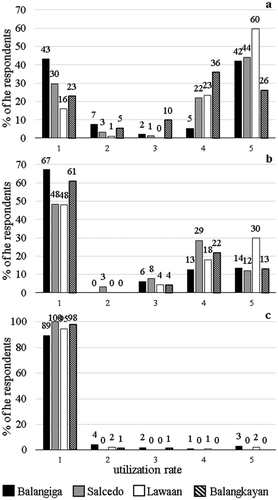
Awareness on regulating services of mangroves was also asked. For coastal protection functions, 44% to 93% of the respondents from the coastal villages said they are extremely aware that mangroves can protect them from strong waves and storm surges. The respondents are moderately to extremely aware that mangroves can purify air and water. However, awareness of the respondents on the role of mangroves to mitigate climate change was relatively low (moderately to not aware); 13% to 25% in Balangiga, 13% to 42% in Salcedo, 15% to 34% in Lawaan and 25% to 65% in Balangkayan.
The respondents from Balangiga (25%-33%), Salcedo (20%-31%), and Lawaan (9%-26%) are slight to very aware that mangrove areas can be used as a recreational site whereas 42% of the sample size in Balangkayan are extremely aware of this cultural value. However, the frequency of using mangrove forests for tourism is low. Majority of the locals, 71% to 97%, have never accessed the mangroves for bird or bat watching and 72% to 92% have never walked along the mangroves using boardwalks ().
Figure 3. Frequency of (a) bird or bat watching and (b) walking along the boardwalk in mangrove forests

and show the results of the correlation analysis employed to the dataset from the four study sites between the socio-demographic profile and frequency of resource utilization and level of awareness on ecosystem services. Based on the analysis done, frequency of usage of the locals correlates with their occupation. The level of education and awareness to some ecosystem services is statistically correlated for Balangiga, Salcedo and Balangkayan whereas no clear correlation found in Lawaan. Negative values that are statistically correlated indicate a reverse relationship between the variables. For example, occupations that are not directly related to fishing can also have high utilization. Housewives could use their time to fish or collect sea foods. Moreover, the relationship between frequency of utilization and awareness to ecosystem services was also tested with the same analysis. The fishing activities of the respondents in Balangiga, Salcedo and Lawaan significantly correlate with their awareness that mangroves are a good source of fishes whereas no significant correlations were found in Balangkayan ().
Table 4. Correlation analysis between the socio-demographic profile and frequency of resource utilization
Table 5. Correlation analysis between the socio-demographic profile and the level of awareness
Table 6. Correlation analysis between the level of awareness and frequency of resource utilization
Mangrove forests management activities
Local government units (LGUs) aid the locals in managing mangrove ecosystems through their coastal plans. We asked the villager the performance of LGUs in the study sites as a benchmark for official local government activities. shows the perceptions of the residents on the effectivity of the assistance provided. About 41% to 57% of the respondents said that the assistance is moderately effective. A few percentages (7%-13%) said that the assistance is extremely effective while others answered slightly effective (5%-9%). About 8% to 13% of the locals from Salcedo, Lawaan and Balangiga said that no assistance was provided.
Figure 4. Level of effectivity of the government’s assistance in managing the blue carbon ecosystems
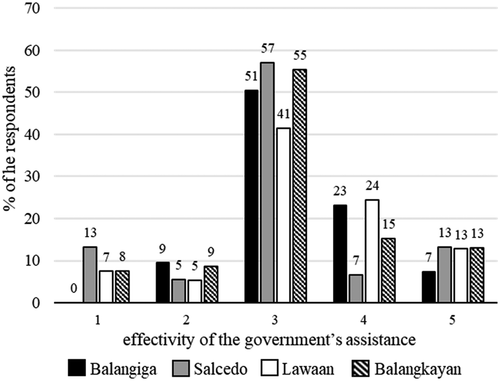
Participation of local communities to coastal management activities such as coastal clean-up and mangrove planting is relatively high. As shown in , 52% to 87% of the respondents engaged in coastal clean-up and 47% to 73% volunteered for mangrove planting. Members from the local government participated in activities like monitoring and evaluation, information and education campaigns and ordinance formulation. Some of the respondents, about 4% to 39% did not participate in any coastal activities. shows that 72% to100% of the locals identified themselves as the one who should safeguard their ecosystems while local and national government along with civil society organizations (CSOs) and private entities were also identified to promote the protection of these coastal resources. Moreover, the participation of local residents to coastal activities could be influenced by the availability and accessibility of the relevant information. We asked the locals whether they were informed or not. Majority of the respondents were informed about the activities though the residents (i.e. neighbors) and their local government.
Figure 5. Percentage participation of the local residents to various coastal management-related activities
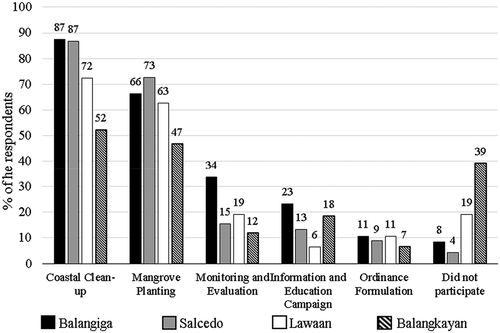
Figure 6. Percentage of the respondents choosing what stakeholder should be responsible for protecting their mangrove forests
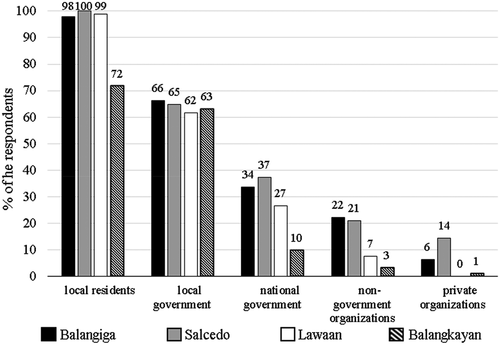
Regression analysis was done to determine the effect of level of awareness on the coastal resource and management plans of their local government to the locals’ awareness on free seminars, trainings, ordinances and local laws and penalties for violations. The results show that the levels of awareness of the locals to these interventions in all four sites are highly influenced by their awareness of existing coastal resource and management plans (). In addition, the participation of the locals in coastal management activities such as mangrove planting is driven by awareness on these activities; they participated if they are informed about the activities.
Table 7. Regression analysis between being informed of the coastal management plans and awareness on local ordinances, laws and penalties for violations as well their participation in coastal management activities
Perceived threats to mangrove ecosystems
The respondents were asked about their perception on how they are likely being affected if these ecosystems are destroyed. shows that in all the municipalities, respondents said that they are extremely affected if their mangrove forests are destroyed, about 66% to 90% of the sample size. Mangroves are vulnerable to natural and anthropogenic threats so we asked the respondent about the perceived threats. Natural disasters such as intense typhoons, storm surges and strong waves are the most concerning threat to mangroves across the study sites as perceived by 30% to 95% of the respondents. In contrast, the least threat to mangrove forests is conversion to fishponds in the municipalities of Balangiga, Salcedo and Balangkayan (35% to 75%) and domestic pollution in Lawaan (35%). Human-induced threats such as illegal cutting of mangroves and charcoal making ranked next to natural disasters with 21% to 46% of respondents from Balangiga, Salcedo and Lawaan while in Balangkayan, pollution from domestic wastes, about 54% of the respondents, ranked second to natural disasters.
Discussion
Mangroves ecosystem services, utilization and awareness
This study determined how the perception of local residents in Balangiga, Salcedo, Lawaan and Balangkayan on mangrove ecosystems and their services translates to their utilization and management practices. Moreover, factors that could influence the local’s utilization of mangrove ecosystem services were explored in this study and will be discussed accordingly. The socio-demographic profile of the respondents plays a significant role on the trends seen in the utilization rate of mangrove forests as a source of fish. Across the study sites, occupation of the respondents statistically correlates with their utilization; fishermen have high utilization whereas farmers, government employees and skilled workers have low utilization. The age and level education of the respondents did not influence the fishing activities of the respondents from Salcedo, Lawaan and Balangkayan. In contrast, the age of the respondents from Balangiga influences the fishing behaviors of the respondents. Although the occupation of the locals could explain the patterns seen in the utilization, the level of awareness that mangroves are a home to fishes and other sea foods is an equally important driver as well. Based on the correlation analysis done, there is a positive correlation; residents with high awareness on the provisioning services of the mangroves have a high utilization rate whereas those with low awareness tends to utilize less. Mangroves are a good source of firewood and raw material for house repair and other constructions (Gomez and Baldago Citation2016); however, results indicated that majority of the coastal villagers never utilized them for said purpose. Field observations and information gathered from the locals have shown that the residents are now using gas stoves and a few using charcoals made out of coconut shells and their respective local government is strictly implementing the “no illegal cutting of mangroves” policy. Moreover, this could also be due to their high awareness of the different ecosystem services offered by the mangrove forests. For example, the respondents in Salcedo and Lawaan are highly aware that fishes can be sourced out from mangroves, so they do not extract trees and branches. This relationship is supported by the results in correlation analysis ().
Cultural services offered by mangrove ecosystems in the Philippines have been welcomed by several local government units. To date, some provinces in the country have well-established tourism activities in mangrove areas such as mangrove eco-parks in Aklan, mangrove boardwalks in Negros Occidental. Although the study sites have mangroves, tourism development in these towns is still in process as mentioned during the field surveys. This lack of tourism activities in mangrove forests could explain why respondents have generally low utilization rate. In terms of awareness, the level of education of the locals influences their perceptions of mangroves as a recreational site based on the results of the correlation analysis ().
Perceptions of the respondents on regulating services of mangroves are driven by several factors. For instance, awareness of the locals on coastal protection against storm surges by mangroves was high which was drawn from locals’ own observations and experiences. During field surveys, respondents shared how mangroves protected them when supertyphoon Haiyan hit their towns. Similar results were found in the perception study conducted in Leyte and Eastern Samar for the coastal protection functions of mangrove forests (Delfino et al. Citation2015). Mangroves can mitigate climate through carbon sequestration (Pidgeon Citation2009; McLeod et al. Citation2011), a unique feature of blue carbon ecosystems. Perceptions of the locals regarding this regulating service vary across the study sites. The low awareness statistically correlates with the level of education attained by the respondents from Balangiga, Salcedo and Balangkayan; those who are college-level and college graduates have high awareness whereas locals who finished elementary and high school have low awareness.
In general, the trends in the utilization rate of mangrove ecosystem services of the respondents are affected by the social demography and level of awareness. In existing studies, utilization and the level of awareness correlate with each other in certain degrees (Asah et al. Citation2014; Zhang et al. Citation2016). The relationships among these three parameters (socio-demography, frequency of use and awareness) vary across the study sites. These variations on the results clearly show that multiple factors could influence the utilization activities of the respondents. Furthermore, it is important to look at multiple factors to better understand the perceptions of the local communities to mangrove ecosystems and their services.
Local government and community involvement in mangrove management
The key results of this study show that the local government has an important role in educating the local communities on coastal resources and management plans. In the Philippines, the Department of Environmental and Natural Resources (DENR) is particular in their implementation of no illegal cutting of mangroves and this is evidenced in the study sites. The zero to low utilization rate of this extractive activity of the locals is influenced by their awareness on the existing local laws, and penalties for violating these laws are high. These indicate that efforts of the local government in prohibiting illegal cutting are effective.
Moreover, local governments’ efforts on conserving and managing the mangrove forests can be interpreted based on the high awareness of the existing coastal plans of the coastal villagers. Results show how being informed of the management activities by the LGUs is important for the locals’ involvement as reflected in regression analyses (). A few of the coastal villagers (47% in Balangiga, 25% in Salcedo, 12% in Lawaan and no one in Balangkayan) have said that information on coastal-related management came from the people’s organizations. These respondents are mostly members of the organization. The study sites have a limited number of peoples’ organizations which are mostly fisherfolks associations which restrict the inclusion of other members of the coastal communities (i.e. farmers, housewives). The presence of people’s organization is also important in the success of managing coastal resources including mangrove ecosystems. For instance, in Banacon Island, Bohol in central Visayas, organizing and strengthening the people’s organization, Banacon fisherfolks and mangrove planters’ association or BAFMAPA has been successful in managing their mangrove forests through mangrove planting and strong commitment in protecting these ecosystems (Gevaña et al. Citation2018).
The role of local government units is essential to managing these ecosystems; however, local stakeholders are equally important as well in the management since they are the ones who manage, use and change these ecosystems (Muhamad et al. Citation2014). The voluntary participation of the locals is consistent with their responses on who should protect the mangrove ecosystems. They are also highly participative in coastal management-related activities like mangrove planting since they are very to extremely aware of the benefits they could get from these resources. The same results from Delfino et al. (Citation2015) when they asked the respondents from municipalities of Eastern Samar and Leyte; majority agreed to the benefits of planting mangroves along the coastlines. Moreover, the local communities in the study sites participated in mangrove planting activities as part of the National Greening Program (NGP) or Executive Order no. 26 of 2014. Monthly coastal clean-ups are also initiated by their local government to help clean the coastal waters. Community-based management in the Philippines has long been applied under Executive Order number 263 of 1995 however it is not fully implemented. Community-based forest management is ideal since it decentralizes the management functions particularly to resource-dependent locals since they have better stakes to the protection and conservation of the ecosystems (Gevaña et al. Citation2018).
The results of this study suggest that the partnership between local communities and government units is important in managing mangrove ecosystems from multiple perspectives. Local government units can educate the communities on the ecosystem services offered by mangrove forests while communities can support their government by active participation and cooperation to coastal management activities.
Implications towards Eco-DRR and blue carbon management
Mangrove forests in the Philippines are facing threats from anthropogenic (Primavera Citation2000; Garcia et al. Citation2013) and natural (Primavera et al. Citation2016) disturbances. Based on the results of the perception survey, 30% of the respondents in Balangiga, 60% in Salcedo, 65% in Lawaan and 95% in Balangkayan said that the most concerning threat to mangroves are natural disturbances such as strong typhoons resulting to storm surges and strong waves. This perception is consistent with the fact that Eastern Visayas is among the provinces frequented by typhoons particularly with the devastation brought about by the super typhoon Haiyan on mangrove forests of Balangkayan (Alura et al. Citation2015), Balangiga (Long et al. Citation2016) and Salcedo and Lawaan (Primavera et al. Citation2016). The effects of the super typhoon Haiyan in Eastern Samar have changed the perspective of the local communities in the study sites. The destruction of the mangrove forests has halted the lives of the coastal villagers in Eastern Samar province. Their number one source of food and income was destroyed and hundreds of people have been displaced.
The ecosystem-based disaster risk reduction (Eco-DRR) as defined by Estrella and Saalismaa (Citation2013) involves a sustainable management, conservation and restoration of ecosystems that provide services which reduce disaster risk and community livelihood resilience. The results of this study showed that majority of the local communities sourced their food () and livelihood () in mangrove ecosystems, one of the blue carbon ecosystems. Their awareness and involvement to various management activities are evident that they are extremely affected if this ecosystem is destroyed. In the Philippines, the National Greening Program (NGP) which involves the restoration of mangrove ecosystems along the coasts aims to lessen the impact of natural hazards and enhance community resilience. Eco-DRR in Eastern Samar province is not being incorporated in their municipal coastal plans; however, not all municipalities have the capacity and financial means to produce coastal plans. Among the study sites, only Salcedo and Lawaan have incorporated Eco-DRR in their plan while Balangiga and Balangkayan only have an ecological profile of their coastal resources.
Moreover, perceptions of local communities to mangrove ecosystems and their services and management in this study suggest that a more comprehensive blue carbon management can be done. The results of the survey show that awareness on climate change mitigating functions of the mangrove forests is relatively low, thus the government should invest more time and funds in educating local communities about blue carbon management. Several studies in the Philippines have shown the capacity of mangroves to sequester carbon (Gevaña et al., Citation2017). For instance, in Banacon Island, Philippines, the community-managed mangrove plantations amassed carbon stock of 64.5 ktC or 236.6 ktCO2e of which 54% of this stock was stored in the sediments (Gevaña et al. Citation2017). The huge potential of Philippine mangroves to sequester carbon indicates the need to have an effective conservation plan. Although mangrove forest management is mostly incorporated in coastal plans at present, this study further suggests that an inclusive conservation and management plan for blue carbon ecosystems, mangrove forests and seagrasses should be formulated and implemented.
Supplemental Material
Download MS Word (476.9 KB)Acknowledgments
We would like to thank the local government unit of Balangiga, Salcedo, Lawaan and Balangkayan province of Eastern Samar for providing the assistance and allowing us to conduct perception surveys in their coastal barangays.
Disclosure statement
No potential conflict of interest was reported by the authors.
Supplemental material
The Supplemental data for this article can be accessed here.
Additional information
Funding
References
- Alongi DM. 2008. Mangrove forests: resilience, protection from tsunamis, and responses to global climate change. Estuarine Coastal Shelf Sci. 76(1):1–13.
- Alura DP, Alura NC, Alura RPC. 2015. Mangrove forest and seagrass bed of Eastern Samar, Philippines: extent of damage by Typhoon Yolanda. IJNRLS. 2(5):30–35.
- Asah ST, Guerry AD, Blahna DJ, Lawler JJ. 2014. Perception, acquisition and use of ecosystem services: human behavior, and ecosystem management and policy implications. Ecosyst Serv. 10:180–186.
- Bakhtiyari M, Lee SY, Warnken J. 2019. Seeing the forest as well as the trees: an expert opinion approach to identifying holistic condition indicators for mangrove ecosystems. Estuar Coast Shelf Sci. 222:183–194.
- Costanza R, de Groot R, Sutton P, van der Ploeg S, Anderson SJ, Kubiszewski I, Farber S, Turner RK. 2014. Changes in the global value of ecosystem services. Glob Environ Change. 26:152–158.
- Crooks S, von Unger M, Schile L, Allen C, Whisnant R. 2017. Understanding strategic blue carbon opportunities in the seas of East Asia. Report by Silvestrum Climate Associates for Partnerships in Environmental Management for the Seas of East Asia (PEMSEA), Conservation International and The Nature Conservancy, with support from the Global Environment Facility and United Nations Development Program. Quezon City, Philippines: Partnerships in Environmental Management for the Seas of East Asia (PEMSEA); p. 1–56. ISBN 978-971-812-040-8.
- Delfino RJP, Carlos CM, David LT, Lasco RD, Juanico DEO. 2015. Perceptions of Typhoon Haiyan-affected communities about resilience and storm protection function of mangrove ecosystems in Leyte and Eastern Samar, Philippines. CDDJ. 1(1):15–24.
- Estrella M, Saalismaa N. 2013. Ecosystem-based DRR: an overview. In: Renaud FG, Sudmeier-Rieux K, Estrella M, editors. The role of ecosystems in disaster risk reduction. Tokyo: United Nations University Press; p. 26–47. ISBN 978-92-808-1221-3.
- Garcia K, Gevaña D, Malabrigo P. 2013. Philippines’ mangrove ecosystem: status, threats, and conservation. In: Faridah-Hanum I, Latiff A, Hakeem K, Ozturk M, editors. Mangrove ecosystems of Asia. New York (NY): Springer; p. 81–94.
- Gevaña DT, Camacho LD, Pulhin JM. 2018. Conserving mangroves for their blue carbon: insights and prospects for community-based mangrove management in Southeast Asia. In: Makowski C, Finkl C, editors. Threats to mangrove forests. Coastal Research Library (Vol. 25). Cham: Springer; p. 579–588.
- Gevaña DT, Camacho LD, Camacho SC. 2017. Stand density management and blue carbon stock of monospecific mangrove plantation in Bohol, Philippines. For Stud. Metsanduslikud Uurimused 66:75–83.
- Gomez RG, Baldago RM. 2016. People’s resource utilization of mangroves and their awareness to its environmental importance. EDKKUJ. 39(3): 35–45.
- Hashimoto S, Nakamura S, Saito O, Kohsaka R, Kamiyama C, Tomiyoshi M, Kishioka T. 2014. Mapping and characterizing ecosystem services of social-ecological production landscapes: case study of Noto, Japan. Sustain Sci. 10(2):257–273.
- Hicks CC, Cinner JE, Stoeckl N, McClanahan TR. 2015. Linking ecosystem services and human-values theory. Conserv Biol. 29(5):1471–1480.
- [MEA] Millennium Ecosystem Assessment. 2005. Ecosystems and human well-being. Washington (DC): Island Press; p. 25–36.
- Kusumaningtyas MA, Hutahaean AA, Fischer HW, Pérez-Mayo M, Ransby D, Jennerjahn TC. 2018. Variability in the organic carbon stocks, sources, and accumulation rates of Indonesian mangrove ecosystems. Estuar Coast Shelf Sci. 218:310–323.
- Long J, Giri C, Primavera J, Trivedi M. 2016. Damage and recovery assessment of the Philippines’ mangroves following super Typhoon Haiyan. Mar Pollut Bull. 109(2):734–743.
- Lukman KM, Quevedo JMD, Kakinuma K, Uchiyama Y, Kohsaka R. 2019. Indonesia Provincial Spatial Plans on mangroves in era of decentralization: Application of content analysis to 27 provinces and “blue carbon” as overlooked components. J Forest Res. doi:https://doi.org/10.1080/13416979.2019.1679328.
- McLeod E, Chmura GL, Bouillon S, Salm R, Bjork M, Duarte CM, Lovelock CE, Schlesinger WH, Silliman BR. 2011. a blueprint for blue carbon: toward an improved understanding of the role of vegetated coastal habitats in sequestering CO2. Front Ecol Environ. 9(10):552–560.
- Muhamad D, Okubo S, Harashina K, Parikesit Gunawan B, Takeuchi K. 2014. Living close to forests enhances people’s perception of ecosystem services in a forest-agricultural landscape of West Java, Indonesia. Ecosyst Serv. 8:197–206.
- Munang RT, Thiaw I, Rivington M. 2011. Ecosystem management: tomorrow’s approach to enhancing food security under a changing climate. Sustainability. 3:937–954.
- Nagelkerken I, Blaber SJM, Bouillon S, Green P, Haywood M, Kirton LG, Meynecke JO, Pawlik J, Penrose HM, Sasekumar A, et al. 2008. The habitat function of mangroves for terrestrial and marine fauna: a review. Aquat Bot. 89(2):155–185.
- Nellemann C, Corcoran E, Duarte CM, Valdrés L, Young CD, Fonseca L, Grimsditch G. 2009. Blue carbon - the role of healthy oceans in binding carbon. UN Environment, GRID-Arendal. Arendal, Norway; p. 1–80. ISBN 978-82-7701-060-1.
- Pidgeon E. 2009. Carbon sequestration by coastal marine habitats: important missing sinks. In: Laffoley DD, Grimsditch G, editors. The management of natural coastal carbon sinks. Switzerland: IUCN, Gland; p. 53.
- Primavera JH. 2000. Development and conservation of Philippine Mangroves: institutional issues. Ecol Econ. 35(1):91–106.
- Primavera JH, Dela Cruz M, Montilijao C, Consunji H, Dela Paz M, Rollon RN, Maranan K, Samson MS, Blanco A. 2016. Preliminary assessment of post-Haiyan mangrove damage and short-term recovery in Eastern Samar, Central Philippines. Mar Pollut Bull. 109(2):744–750.
- Spalding MD, McIvor AL, Beck MW, Koch EW, Möller I, Reed DJ, Rubinoff P, Spencer T, Tolhurst TJ, Wamsley TV, et al. 2013. Coastal ecosystems: a critical element of risk reduction. Conserv Lett. 7(3):293–301.
- Zhang W, Kato E, Bhandary P, Nkonya E, Ibrahim HI, Agbonlahor M, Ibrahim HY, Cox C. 2016. Awareness and perceptions of ecosystem services in relation to land use types: evidence from rural communities in Nigeria. Ecosyst Serv. 8(Part A):150–160.
- Zitti M, Ferrara C, Perini L, Carlucci M, Salvati L. 2015. Long-Term Urban Growth and Land Use Efficiency in Southern Europe: implications for Sustainable Land Management. Sustainability. 7:3359–3385.

